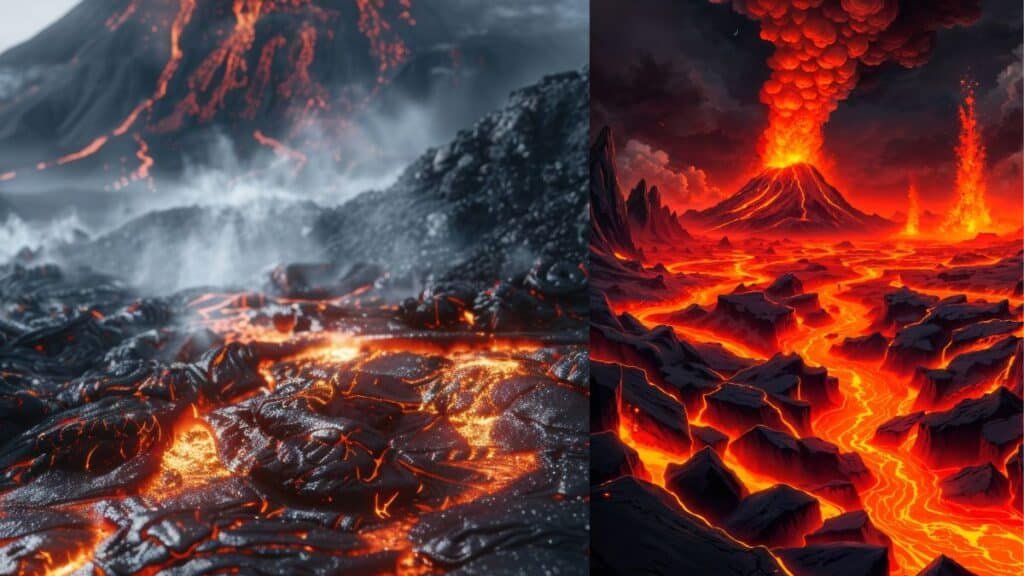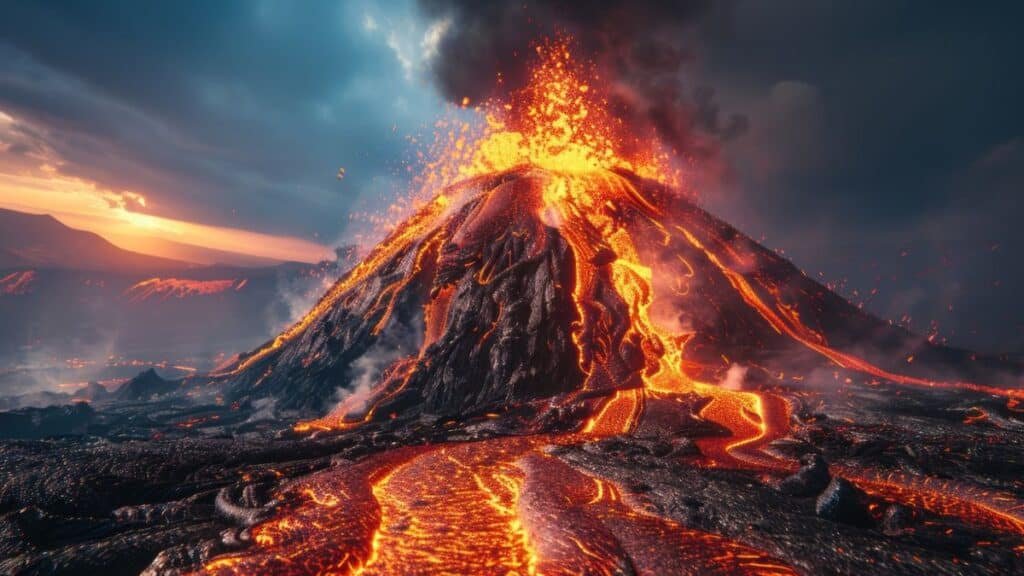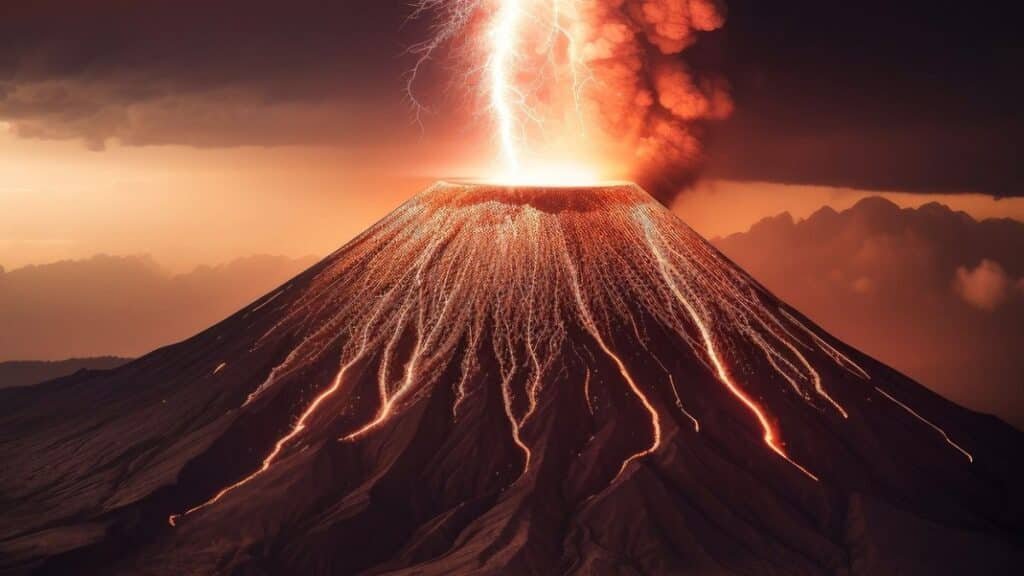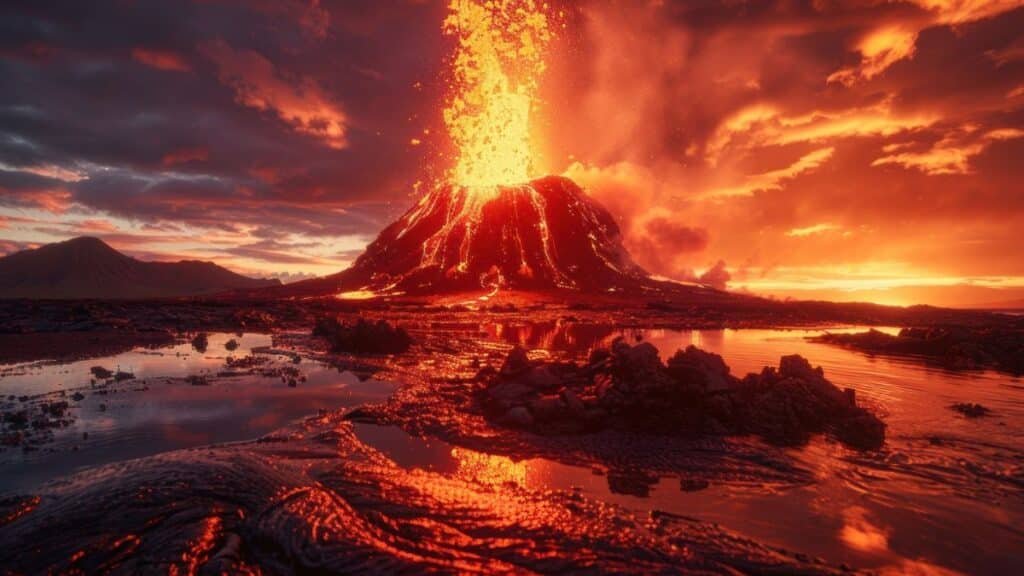What is Volcano: Iceland recently experienced another volcanic eruption, marking its 12th since 2021. The small town of Grindavik, in particular, has been dealing with frequent volcanic activity since November 2023. Despite the eruption, local authorities assure that the new lava flows do not pose a threat to the town. According to Iceland’s meteorological department, the lava is flowing through a 700 to 1,000-meter-wide crack in the barren land, heading southeast. Right now, the lava doesn’t endanger any infrastructure.
What Really Happens During a Volcanic Eruption?
A volcanic eruption happens when there’s a disruption in the Earth’s crust that allows magma (molten rock) from beneath the surface to escape. Here’s how it works: deep within the Earth, intense heat melts rocks into a viscous liquid called magma. Since magma is lighter than solid rock, it rises and gathers in chambers. Eventually, it pushes through cracks in the Earth’s crust, causing an eruption. The material that flows out is called lava, which hardens and solidifies over time.

Understanding the Earth’s Layers: A Key to Volcanic Eruptions
To get why volcanic eruptions occur, we need to look at Earth’s structure. At the top, you have the crust, which is the outermost layer. Underneath this is the mantle, which is made of thick, mostly solid rock, although some parts are semi-solid. The crust ranges from 10 to 100 kilometers thick in mountainous areas. Magma contains water, sulfur dioxide, carbon dioxide, and other dissolved gases. These gases are what cause the pressure to build up, eventually leading to an eruption when magma reaches the surface.
How Does Magma Erupt? Here’s the Deal
Now, let’s talk about how magma behaves under all that pressure. Inside the Earth, conditions are extreme. The pressure builds, and temperatures reach up to 1000°C. As magma rises, it looks for weak spots in the Earth’s crust to escape. When it finally breaches the surface, it doesn’t just spill out casually. Instead, it erupts with force, spewing ash, gas, and molten rock. As the magma cools and hardens, it forms the familiar landscape of volcanic cones, lava domes, or shields.
Types of Volcanoes: How Lavas Shape Their Look
Volcanoes vary depending on how the magma behaves. If the lava is runny and flows easily, it forms broad, shield-like volcanoes. But if the lava is thick and sticky, it builds up and forms steeper, conical volcanoes. In some cases, when thick lava accumulates, it forms a lava dome. It’s all about the viscosity of the lava and how easily it flows.

Where Are Volcanos Located Around the World?
Volcanoes are primarily found along the boundaries of tectonic plates, where these plates either collide, move apart, or slide past one another. There are three main volcanic belts around the globe.
- The Pacific Ring of Fire: This is the hotspot for volcanoes. It stretches from New Zealand all the way to Japan and includes parts of North and South America. Indonesia, in particular, has the highest concentration of active volcanoes.
- Mid-World Mountain Belt: Stretching across the Alpine-Himalayan mountain range, this area has a few volcanoes, but not as many as the Ring of Fire.
- African Rift Valley Belt: Found in East Africa, this belt hosts several volcanoes, such as Mount Kilimanjaro and Mount Meru in Tanzania and Kenya.
There are also “hot spots” in the Earth’s interior where volcanic activity occurs, like the Hawaiian Islands.

Volcanic Eruptions: Destruction and Benefits
Sure, volcanic eruptions can be terrifying and destructive, but they also bring some unexpected benefits. Here’s what you need to know:
- Fertile Soil: The ash and lava from eruptions contain essential nutrients like iron, magnesium, and potassium. Over time, when they cool and break down, they turn into fertile soil. That’s why farming thrives in volcanic regions. For example, vineyards thrive around Mount Vesuvius in Italy, and in India, the black soil of the Malwa Plateau is rich due to ancient volcanic activity.
- Minerals and Precious Stones: The lava from volcanoes can contain valuable minerals, and even precious stones. Obsidian, a type of natural glass, was historically used for tools and jewelry.
- Geothermal Energy: Volcanic regions are a goldmine for geothermal energy, which is used for electricity generation. This energy source is clean, renewable, and increasingly popular in countries like Iceland, New Zealand, and Indonesia.
- Tourism: The beauty and power of volcanoes attract tourists. Volcano trekking, hot springs, and geothermal activities are popular tourist attractions, which boost the local economy.
Volcanoes and Climate Change
When major volcanic eruptions occur, they can affect global temperatures. The ash and sulfur dioxide released into the atmosphere can reflect sunlight, which leads to temporary global cooling—a phenomenon known as “global dimming.” This effect is short-lived, though, and volcanic eruptions also release greenhouse gases that contribute to long-term climate change.
Read More: The 6 Most Powerful Carrier-Based Fighter Jets Today
Watch India Pakistan Breaking News on The Ink Post. Get Latest Updates, Latest News on Movies, Breaking News On India, World, Explainers.
Follow us on Facebook and Instagram and LinkedIn and Twitter to Stay updated!




